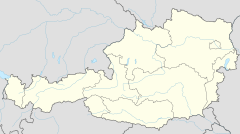This is an old revision of this page, as edited by HylgeriaK (talk | contribs) at 15:43, 14 December 2024 (←Created page with '{{Infobox religious building | building_name = Elisabethinenkirche (Church of St. Elizabeth) | infobox_width = | image = GuentherZ 2008-04-26 0730 Krankenhaus Sankt Elisabeth.jpg | image_size = 500px | alt = | caption = | map_type = Austria Vienna#Austria | map_size = | map_caption = | location = Vienna, Austria | geo...'). The present address (URL) is a permanent link to this revision, which may differ significantly from the current revision.
Revision as of 15:43, 14 December 2024 by HylgeriaK (talk | contribs) (←Created page with '{{Infobox religious building | building_name = Elisabethinenkirche (Church of St. Elizabeth) | infobox_width = | image = GuentherZ 2008-04-26 0730 Krankenhaus Sankt Elisabeth.jpg | image_size = 500px | alt = | caption = | map_type = Austria Vienna#Austria | map_size = | map_caption = | location = Vienna, Austria | geo...')(diff) ← Previous revision | Latest revision (diff) | Newer revision → (diff)| Elisabethinenkirche (Church of St. Elizabeth) | |
|---|---|
 | |
| Religion | |
| Affiliation | Roman Catholic |
| District | Landstraße (3. Bezirk) |
| Rite | Roman Rite |
| Year consecrated | 1749 |
| Status | Active |
| Location | |
| Location | Vienna, Austria |
  | |
| Geographic coordinates | 48°12′18.9″N 16°23′11.89″E / 48.205250°N 16.3866361°E / 48.205250; 16.3866361 |
| Architecture | |
| Architect(s) | Franz Anton Pilgram |
| Type | Church |
| Style | Baroque |
| Completed | 1748 |

The Elisabethinenkirche (Church of St. Elizabeth) is a convent church located next to the convent and St. Elisabeth's Hospital in the 3rd Viennese district of Landstraße at Landstraßer Hauptstraße 4a.
In 1710, during the renovation of the Bartolotti Houses, a small wooden church was built with a donation from the imperial family and consecrated in 1711. In 1718, a hospital was built according to the plans of the master builder Franz Jänggl. After destruction by a flood in 1741, the convent was rebuilt and the church was rebuilt in 1743 by the architect Franz Anton Pilgram. The main donor was now the Prince-Primate of Hungary, Archbishop Emmerich Esterházy. The church was largely completed in 1748. The consecration took place in 1749, the same year the pharmacy was opened as a donation from Empress Maria Theresa.
The facade of the church makes the observer believe that the church is aligned at right angles to the street. In reality, the nave is parallel to the street.
Organ
The organ from 1898 was built by Johann Marcell Kauffmann and has 14 stops.
Bells
There are currently three bells in the church. Two of them hang in the church tower, the smallest hangs in the roof turret.
| No. | Note | Weight
(kg) |
Diameter
(cm) |
Bellfounder | Year of casting |
|---|---|---|---|---|---|
| 1 | g | 480 | 95 | Josef Solonati | 1748 |
| 2 | c | 246 | 74.1 | Josef Pfundner | 1948 |
| 3 | d | 105 | 56 | Johann Achamer | 1710 |
The large bell has round arch openings in the mantle, each containing a crucifix.
Hospital Chapel
In the hospital wing built between 1834 and 1836 by the master builder Josef Eyselt, there is a rectangular barrel-vaulted chapel with a dome and gallery in the Nazarene style.
Literature
- Wien. Dehio-Handbuch. Die Kunstdenkmäler Österreichs. Vol. Band 2: II. bis IX. und XX. Bezirk, III. Bezirk Landstraße, Elisabethinen-Kirche hl. Elisabeth mit Kloster und Spital. Wien: Verlag Anton Schroll & Co. 1993. pp. 47–52. ISBN 3-7031-0680-8.
External links
- Elisabethinenkirche in the Vienna History Wiki
References
- Wernisch, Jörg (2011). Glockenverzeichnis von Österreich [Bell register of Austria]. Lienz: Journal-Verlag. p. 223. ISBN 978-3-902128-16-4.